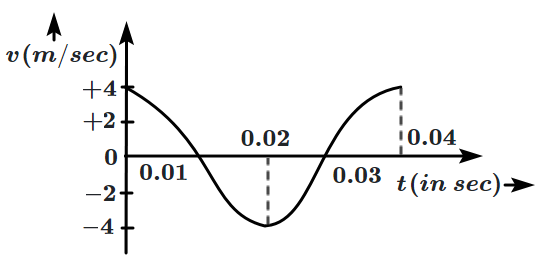| List-I | List-II |
| (a) motion with constant speed | (i) SHM |
| (b) motion with constant acceleration | (ii) uniform circular motion |
| (c) oscillatory motion | (iii) projectile motion |
| (d) random motion | (iv) molecular motion in gas |
Codes:
| 1. | a - (iv), b - (ii), c - (iii), d - (i) |
| 2. | a - (i), b - (iii), c - (ii), d - (iv) |
| 3. | a - (ii), b - (iii), c - (i), d - (iv) |
| 4. | a - (ii), b - (iii), c - (iv), d - (i) |
The angular velocities of three bodies in simple harmonic motion are with their respective amplitudes as . If all the three bodies have the same mass and maximum velocity, then:
| 1. | \(A_1 \omega_1=A_2 \omega_2=A_3 \omega_3\) |
| 2. | \(A_1 \omega_1^2=A_2 \omega_2^2=A_3 \omega_3^2\) |
| 3. | \(A_1^2 \omega_1=A_2^2 \omega_2=A_3^2 \omega_3\) |
| 4. | \(A_1^2 \omega_1^2=A_2^2 \omega_2^2=A^2\) |
If a particle in SHM has a time period of \(0.1\) s and an amplitude of \(6\) cm, then its maximum velocity will be:
1. \(120 \pi\) cm/s
2. \(0.6 \pi\) cm/s
3. \(\pi\) cm/s
4. \(6\) cm/s
An SHM has an amplitude \(a\) and a time period \(T.\) The maximum velocity will be:
1. \({4a \over T}\)
2. \({2a \over T}\)
3. \({2 \pi \over T}\)
4. \({2a \pi \over T}\)
Two equations of S.H.M. are and . The phase difference between the two is:
1. \(0^\circ\)
2. \(\alpha^\circ\)
3. \(90^\circ\)
4. \(180^\circ\)
Which one of the following statements is true for the speed 'v' and the acceleration 'a' of a particle executing simple harmonic motion?
| 1. | The value of a is zero whatever may be the value of 'v'. |
| 2. | When 'v' is zero, a is zero. |
| 3. | When 'v' is maximum, a is zero. |
| 4. | When 'v' is maximum, a is maximum. |
In simple harmonic motion, the ratio of acceleration of the particle to its displacement at any time is a measure of:
| 1. | Spring constant | 2. | Angular frequency |
| 3. | (Angular frequency)2 | 4. | Restoring force |
The equation of motion of a particle is \({d^2y \over dt^2}+Ky=0 \) where \(K\) is a positive constant. The time period of the motion is given by:
| 1. | \(2 \pi \over K\) | 2. | \(2 \pi K\) |
| 3. | \(2 \pi \over \sqrt{K}\) | 4. | \(2 \pi \sqrt{K}\) |
The motion of a particle varies with time according to the relation
\(y= a\sin\omega t+ a\cos \omega t\). Then:
| 1. | The motion is oscillatory but not SHM |
| 2. | The motion is SHM with an amplitude \(a\sqrt{2}\) |
| 3. | The motion is SHM with an amplitude \(\sqrt{2}\) |
| 4. | The motion is SHM with an amplitude \(a\) |
The velocity-time diagram of a harmonic oscillator is shown in the figure given below. The frequency of oscillation will be:
1. 25 Hz
2. 50 Hz
3. 12.25 Hz
4. 33.3 Hz



